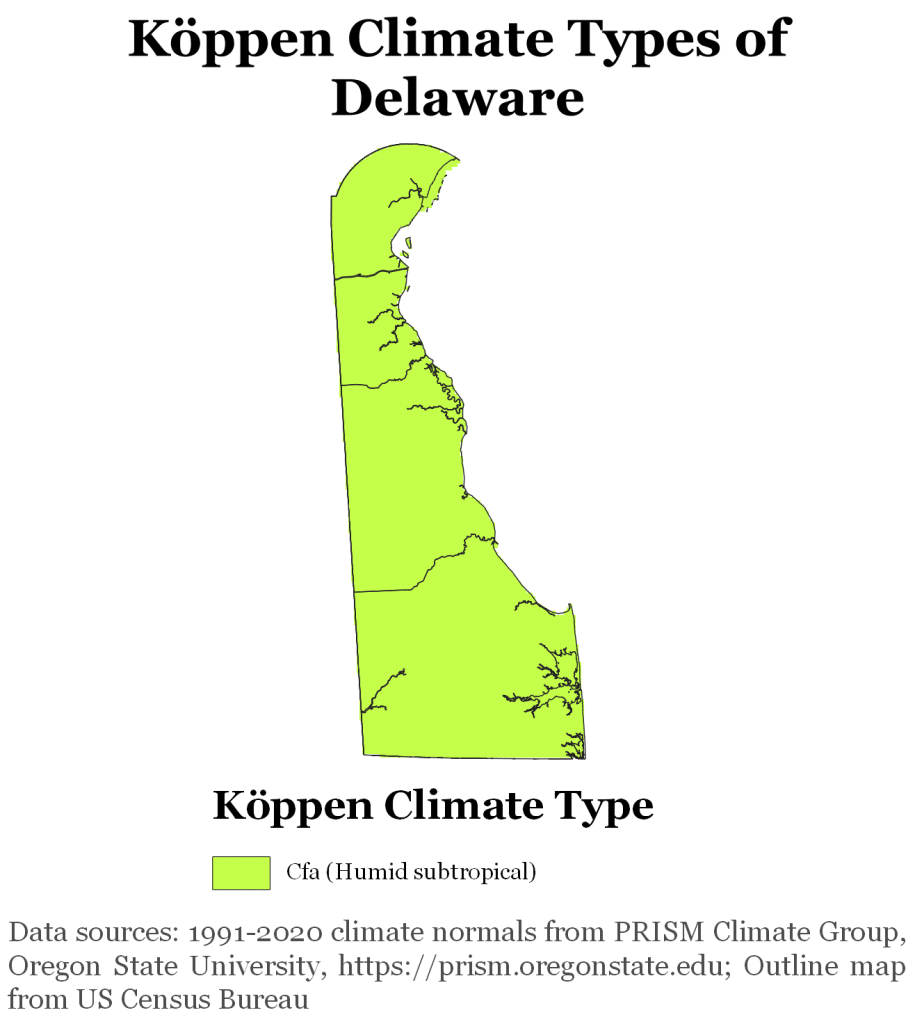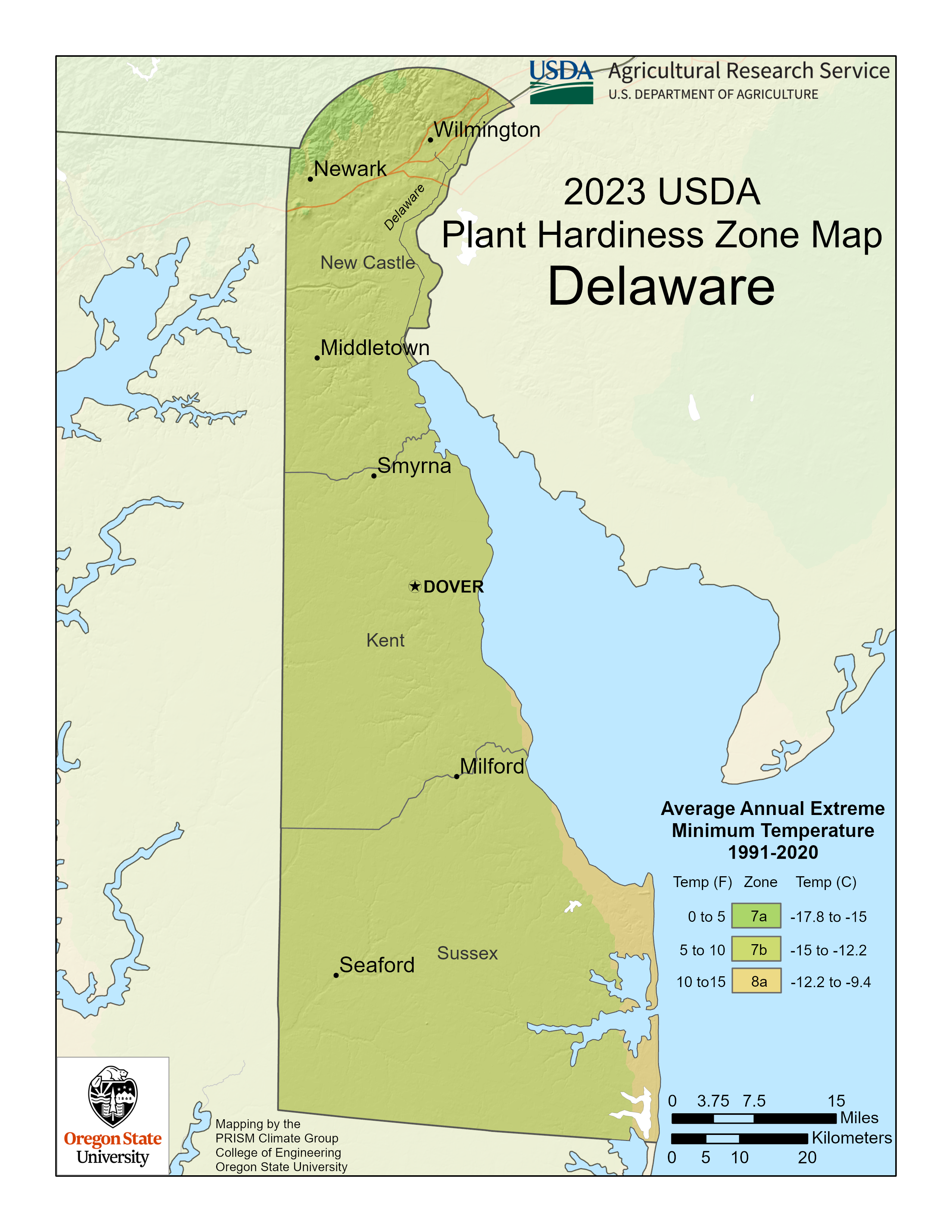Delaware Plant Hardiness Zones
| USDA Hardiness Zone | Average Minimum Extreme Winter Temperature Range Fahrenheit (°F) Celsius (°C) | Average Last Frost Date Range In Spring (Beginning Of The Growing Season) | Average First Frost Date Range In Autumn (End Of The Growing Season) |
|---|---|---|---|
| 7a | 0°F to 5°F -17.8°C to -15°C | Mid-April | Late October |
| 7b | 5°F to 10 °F -15°C to -12.2 °C | Early to mid-April | Late October to early November |
Delaware Growing Conditions
General Climate

Delaware has a humid subtropical climate. This means the state experiences mild-temperate weather overall, with no distinct dry season and a hot summer.
The northern part of Delaware is in plant hardiness zone 7a, which means it experiences a slightly shorter growing season, with temperatures remaining cooler in the winter months.
The southern and coastal parts of the state are in zone 7b, which experiences warmer summers and a slightly longer growing season.
Delaware experiences precipitation throughout the year, and droughts rarely occur. Severe thunderstorms can lead to flash flooding and tornadoes in this state.
Microclimates
USDA plant hardiness zones are an important starting point for your garden, but you’ll also need to consider microclimates.
Microclimates are areas where specific conditions create a climate different from the climate they’re situated in.
Buildings, fences, paved areas, or short hills and valleys can create these microclimates.
They can be as small as a space in your backyard or as large as a city.
In other words, learn about your local conditions from local experts to see if your garden falls into a microclimate.
Extreme Weather
Coastal Storms
Delaware can experience severe thunderstorms during the spring and summer seasons, which can bring lightning, strong winds, heavy rain, major flooding, and tornadoes to the state.
This can look like Nor’ Easters in the winter, with strong winds, heavy snowfall, and ice accumulation. Winter garden prep, including mulching, will help keep your plants alive through the winter.
Planning for these types of weather events is crucial to the protection and survival of your garden. Native plants acclimated to the area will do better than non-native plants, which will be more susceptible to extreme weather.
Flash Flooding
In Delaware, flooding is the most common extreme weather event. Flooding can be detrimental to a garden and damage plants, property, and tools. Prior planning can help mitigate the damages of flooding.
Drain and rain garden installations can greatly reduce flooding by directing water away from your property and garden space.
Water-tolerant plants are also advantageous when working with Delaware’s weather systems. Native plants are more adaptable to the climate and can be resilient in the face of extreme weather.
Tornadoes
Tornadoes bring high winds, flash floods, hail, and other extreme weather patterns to Delaware. They can be detrimental to your garden, but with a little planning and a whole lot of luck, you can prepare your gardens for tornado season.
Tornado season typically occurs in mid-spring to early summer. Although tornadoes are not typically common in Delaware, the state can experience one tornado on average a year.
Choosing plants with strong root systems is a great way to mitigate tornado season. Potting favorite plants and bringing them inside can also increase their survival rate during extreme storms.
Growing Season
Delaware has a moderate growing season. It typically lasts 170-200 days, extending from early April to early November (depending on whether you live in zone 7a or 7b).
The coast of Delaware can be, on average, 10 degrees warmer in the summer and 10 degrees cooler in the winter. Knowing your zone within the state is helpful, as is knowing what types of plants will do well there. Some plants that thrive on the coast may not grow well in the northern inland area of the state.
Delaware Gardening Tips

Choose The Right Plants
Choosing the right plants is one of the most critical factors in growing a successful garden. Knowing the species of plant best suited to your particular environment will help create impactful, long-lasting gardens.
Adding native plants to your garden can increase biodiversity, support pollinators, and withstand region-specific environmental elements. These plants are more resilient, use less water, and help create sustainable landscapes.
Knowing Your Location
There are two distinctly different growing environments in Delaware. One is the Piedmont growing environment, a small portion of the state in the far north corner. Hilly terrain with steep valleys dominates this landscape with lots of rocky, eroded soil.
Choosing plants that focus on deep root development can help stabilize the soil and build strong foundations in your garden.
The second growing zone within Delaware is the coastal plains, which cover the majority of the state. A coastal plain environment consists of low-lying tidal estuaries close to the sea.
This area consists mostly of sandy soil with varying drainage, as some marshes have clay-based soils. Adding organic matter to heavy and sandy soils can break up clay, improve drainage, and build healthy soil. Organic matter can consist of compost or even leaf mulch added to your garden each fall.
Consult With Local Professionals
Consulting with local gardening professionals allows you to benefit from their experience with your area’s conditions, the plants that do well there, and overall best practices.
Delaware Plant Suggestions

Trees
- Bur Oak (Quercus macrocarpa)
- Sweet Birch (Betula lenta)
- Sugar Maple (Acer saccharum)
Shrubs
- Witchhazel (Hamamelis virginiana)
- Silky Dogwood (Cornus amomum)
- Strawberry bush (Euonymus americanus)
Flowers
- Common Yarrow (Achillea millefolium)
- Wild Lupine (Lupinus perennis)
- Wild Bergamot (Monarda fistulosa)
Vegetables
- Daikon Radish (Raphanus sativus longipinnatus)
- Shallot (Allium ascalonicum)
- Potato Red Norland (Solanum tuberosum)
Herbs
- Lavender (Lavandula ‘Goodwin Creek Grey’)
- Greek Oregano (Origanum vulgare)
- Lemon Thyme (Thymus citriodorus)
Spices
- Ginger (Zingiber officinale)
- Turmeric (Curcuma longa)
- Garlic (Allium sativum)
Fruits
- American Plum (Prunus americana)
- Paw Paw (Asimina triloba)
- Red Mulberry Tree (Morus rubra)
Succulents
- Wild Stonecrop (Sedum ternatum)
- Golden Stonecrop (Sedum makinoi)
- Six-Sided Stonecrop (Sedum sexangulare)
Disclaimer
Any of the above can change and is not exhaustive.
Treat anything above like a good starter guide. Then use that as a foundation as you consult with local gardeners, professionals, forecasts, guides, and organizations.

